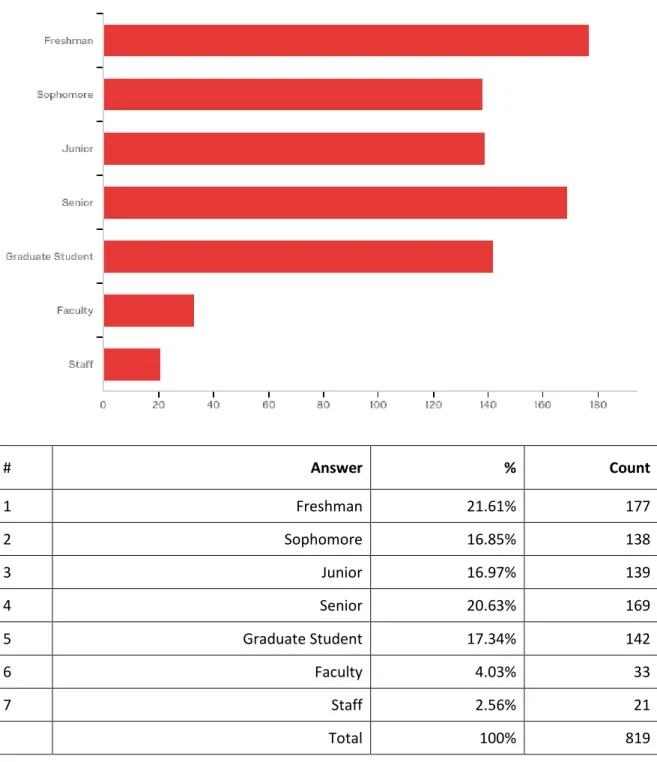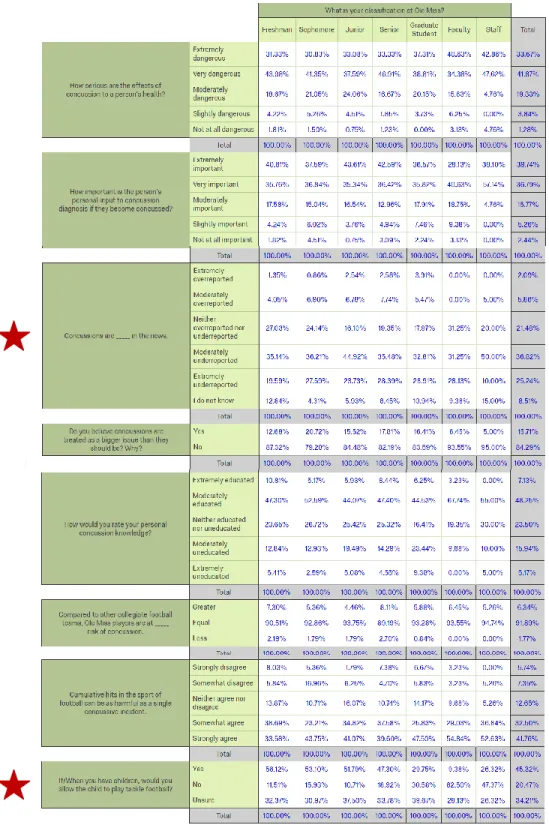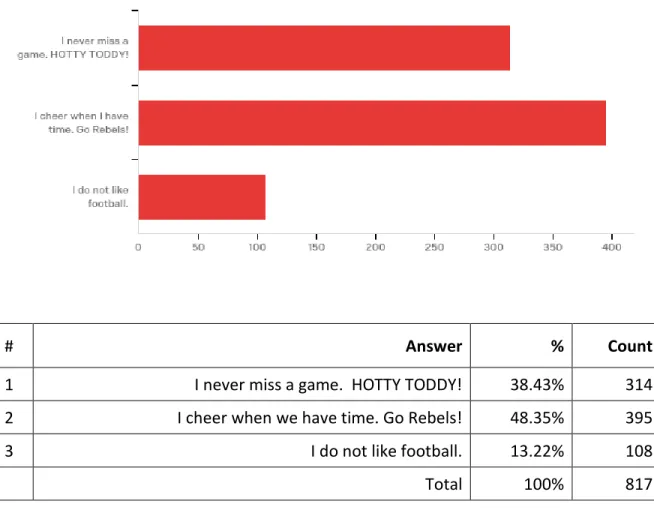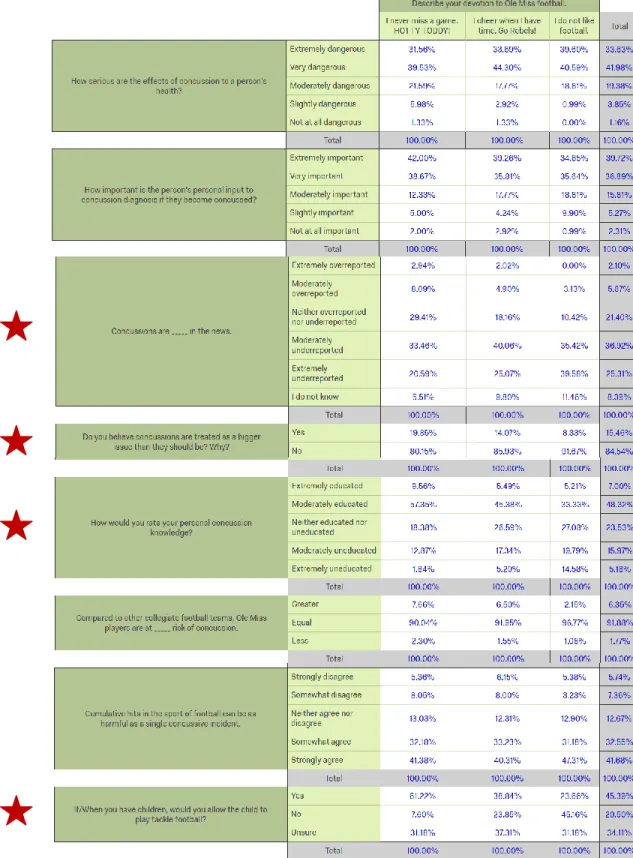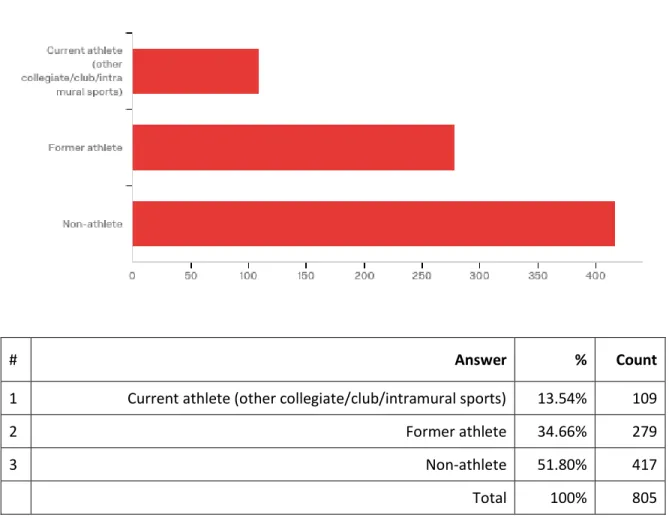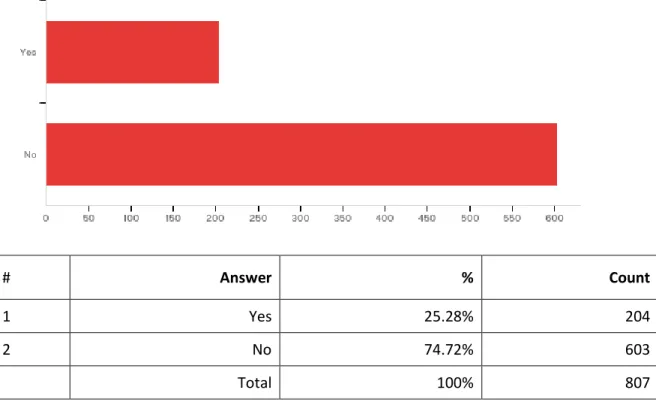Concussions are common in the sport of soccer due to the highly physical nature of the sport, and injured athletes can experience a variety of symptoms. Mississippi regarding their views on the effects and associated risks of concussions on Ole Miss players. The thalamus regulates and processes information sent from the rest of the central nervous system to the cerebral cortex.
Changes in the structure of the temporal lobe have been observed in retired professional athletes with known concussion. The brain can rotate on itself and/or collide with the bony walls of the skull. In game and practice settings at the University of Mississippi, players with suspected concussions are assessed using portions of the SCAT3 test to determine.
Regarding the median number of days, athletes in the experimental group obtained medical clearance in 15.5 days and reached Omalu goes so far as to say that allowing children to play football is "the definition of child abuse." It further advises that no person under the age of eighteen should be allowed to participate in tackle football (Axson, 2017). In our study, we sought to explore the perceptions of the Ole Miss community regarding their knowledge of the above information in addition to their perceptions of concussions in football as a whole.
What is your classification at Ole Miss?
To determine interest in sports, participants were asked to rank their commitment to Ole Miss football. We hypothesized that participants reporting greater commitment to Ole Miss football would indicate that turmoil in today's society is exaggerated. Fisher's exact analysis indicated that participants who did not report a commitment to Ole Miss football were less likely to indicate that concussions were viewed as more of a problem than they should be ( p <0.05).
Additionally, participants who reported no devotion to Ole Miss football were found to identify as less educated in terms of their personal knowledge about concussions than participants with a moderate to high level of devotion, according to Fisher's exact analysis. Graphical representation from SigmaPlot reveals that males and females reported approximately equal levels of devotion to Ole Miss. A cross-tabulation chart (Figure 6) from Qualtrics highlights that none of all participants indicated that concussions were extremely over-reported in the news. identified as having no affection for Ole Miss football; all who perceived concussions as extremely overreported in the news claimed a moderate or high devotion to Ole Miss football.
Chi-square analysis revealed that a significant number of participants without affection indicated that concussions are extremely underreported in the news.
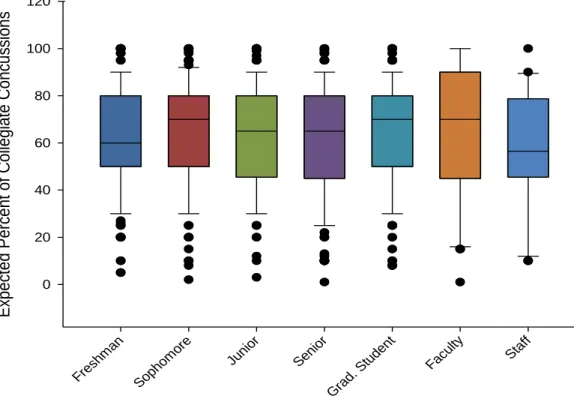
Describe your devotion to Ole Miss football
We hypothesized that participants who report current or previous involvement in sports would have more knowledge about concussions. Of the 10 selected, 5 would continue to play football at a professional level if they were given the opportunity. Of the remaining participants, 13.54% identified as current athletes in collegiate (other than football), club, and/or intramural sports, 34.66% as former athletes, and 51.80% as non-athletes (Figure 7).
Participants who self-identified as current or former athletes were asked to select all sports other than soccer in which they participated (Figure 8). While concussions can result from any form of activity, the available responses to this question were the sports that we thought were the most common and most likely to cause concussions. A significant difference (p < 0.05) can be found between the ratings of personal knowledge of concussions for participants of each athletic status.
Using a Fisher's exact test, it was found that significantly more non-athletes identified as neither educated nor uneducated. Reviewing the cross-tabulation plot (Figure 9) of athletic status and personal knowledge ratings, most participants report. According to Fisher's exact analysis, non-athletes report significantly less commitment than current or former athletes.
There was also a significant difference in participants having or not being diagnosed with concussion (p < 0.05). It also found that non-athletes significantly report that concussions are grossly underreported in the news when compared to the responses of current and former athletes. Finally, chi-square analysis shows a significant difference (p < 0.05) in current, former, or non-athlete responses regarding whether they would, would not, or were unsure whether to allow their child(ren) to play football.
Of those participants who indicated that they would not allow their child(ren) to play soccer, 60.87% identified as non-athletes; Non-athletes are much less likely to allow their child/children to play technique football.
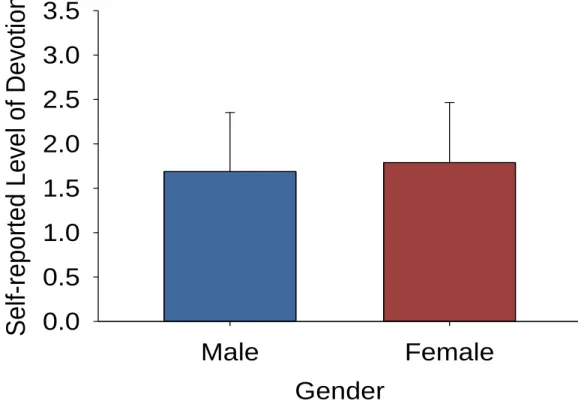
In which sports were/are you a participant?
Figure 8a, 8b: Sports other than football included by participants who selected “current athlete” or “former athlete”. While almost half of the participants indicated current or previous involvement in sports, only 25.28% of the sample reported having a medical diagnosis of concussion (Figure 10). Those who chose yes were asked to list the number of medically diagnosed concussions they had experienced.
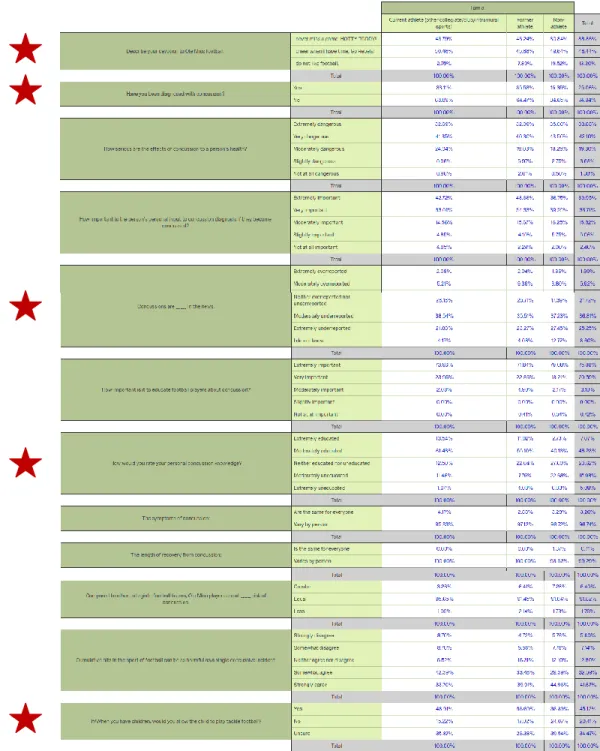
Have you been diagnosed with concussion?
How serious are the effects of concussion to a person's health?
Because concussion symptoms are unique to each individual, it is important that players communicate their health with coaches and trained medical professionals. This may be due to fear of disappointing the team, the impact of high adrenaline levels or ignoring symptoms. In a gaming environment, players may not honestly report the severity of their symptoms for fear of being removed from the game.
Because of this, we wanted to examine the perceived importance of a concussed player's concussion input. We believed that the majority of participants would attach importance to a player's communication about their injury.
How important is the person's personal input to concussion diagnosis if they become concussed?
To make diagnoses, doctors can use a variety of tools to examine a player's memory, balance and cognitive function, and 95.51% of the sample believed there were methods to assess an athlete for concussion. Regarding the media, we believed that participants would indicate that concussions are overreported by the media due to the recent increase in concussion coverage. However, the results show that the majority of participants believe that concussions are moderately to extremely underreported.
Additionally, 15.71% of responses indicated that concussions are seen as a bigger problem than they should be in general. In numerical terms, the mean response was 4.03, with 1 being “extremely too much” and 6 being “don't know,” indicating that participants perceive.
Concussions are _____ in the news
How important is it to educate football players about concussion?
How would you rate your personal concussion knowledge?
The majority of participants (95.53%) correctly identified that concussions can occur from both a single, severe concussive event AND an accumulation of minor, repeated tackles/hits. Furthermore, 41.76% of responses support that cumulative hits can be as damaging as a single concussion event. In this study, we sought to investigate whether participants could identify common symptoms of concussion.
As head injuries are involved, we expected participants to include headache as a symptom of concussion, which 98.46% did. Although recent research has shown a transient increase in heart rate after concussion, further testing is needed to confirm such findings (Dobson, Yarbrough, Perez, Evans, & Buckley, 2017).
What are common symptoms of concussion? (Select all that apply.)
Participants' responses indicated that most believe the average recovery period lasts more than a week but less than a month. In terms of athletic status, participants who identified as non-athletes tended to report longer periods of post-concussion recovery (Figure 18). Current research by the NCAA aims to better determine the average duration of recovery among concussed athletes.
A 2017 study explains that not all athletes agree to participate in research studies, which has proven to be a challenge in ensuring accurate results (Broglio et al., 2017). Some websites advise an injured athlete to wait at least seven to ten days before returning to play (Okragly, 2018). Progression through the NCAA's phased return-to-play process is contingent upon cessation of symptoms.
On average, it takes _____ for a concussed college football player to recover
Limitations and Future Studies
This or a similar survey could be conducted annually by University of Mississippi students, faculty, and staff to determine how perceptions change over time. In the future, it may be helpful to develop a flyer to distribute around campus to educate the Ole Miss community about the risks of concussions. In addition, the flyer may contain links to information published by the NCAA and to links specific to Ole Miss policies and procedures.
Regarding changes that may be made to this survey for future use, the wording of the questions and answer choices may be reconsidered. A follow-up question can be asked so that the participant can justify their answer. Rather than asking participants to select all that apply, participants can be asked to list common symptoms of concussion in a text entry format.
Finally, as was the original goal of this study, Ole Miss football players can be screened using the ImPACT and SCAT3 tests before, at checkpoints during, and after the end of the season to assess how their cognitive/clinical outcomes change over time. the course of the season. An additional survey could be distributed to students, faculty, and staff at the University of Mississippi and comparisons could be made between the two populations. A national study of the effects of concussion in collegiate athletes and members of the US Military Service Academy: Structure and Methods of the NCAA-DoD Concussion Evaluation, Research, and Education (CARE) Consortium.
Sensitivity and specificity of the online version of the ImPACT in high school and college athletes. Skip to: End of Survey If we prove we are 18 or older. Purpose: Madison Frerker (SMBHC '18) is seeking to gather responses from University of Mississippi residents regarding their perceptions of concussions in the sport of college football.
Skip to: End of Survey If the purpose: Madison Frerker (SMBHC '18) wants to collect responses from people Univ. Have you been or are you currently involved in soccer at a level other than the NCAA collegiate level? If you have been or are currently playing football at a non-NCAA collegiate level.
What percentage of collegiate football players do you think experience concussions in their college careers.
